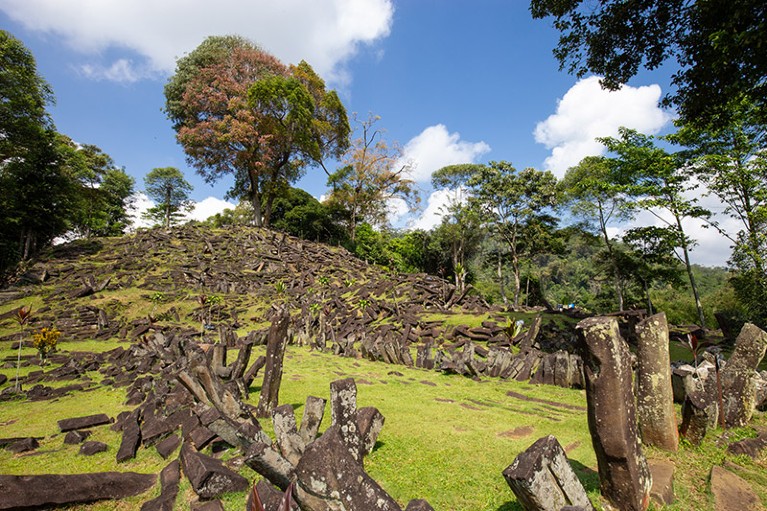Hello Nature readers, would you like to get this Briefing in your inbox free every day? Sign up here.
Gunung Padang is “an amazing, important and cool site”, but whether it is the world’s oldest stone structure is contested.Credit: Ali Trisno Pranoto/Getty
Furore over ‘oldest pyramid’ claim
A paper claiming that a structure in Indonesia is the oldest pyramid in the world has raised the eyebrows of archaeologists and prompted an investigation by publisher Wiley’s ethics team. The study concludes that a structure lying beneath the prehistoric site of Gunung Padang in West Java might have been constructed as far back as 27,000 years ago — long before Egypt’s great pyramids. However, critics say that the buried layers are more likely to have occurred naturally, and that there’s no evidence people had the skills to build a pyramid at the time. The site has been linked to a fringe idea of an advanced global civilization that was wiped out 12,000 years ago, at the end of the last ice age.
Nature | 5 min read
Reference: Archaeological Prospection paper
Anglerfish lives life upside down
Several species of whipnose anglerfish (Gigantactis spp.) have been spotted swimming belly-up, suggesting that this is normal behaviour for these deep-sea creatures. “Just when you think they couldn’t get any weirder, anglerfish outdo themselves,” says biologist Pamela Hart. Whipnose anglerfish live in the lightless depths of the ocean. Females use the bioluminescent tip of their long fishing-rod-like nose appendage to lure in prey — apparently while upside down. The researchers suggest that this position allows the fish to take down larger and faster animals without accidentally biting themselves.
The New York Times | 4 min read
Reference: Journal of Fish Biology paper
Babies start learning language before birth
Babies seem to be primed to learn their native language by listening to their mother’s voice while still in the womb. In a study of 33 newborns, the infants’ brain activity showed more signs of learning after listening to recordings of their native language than of other, similar languages. This doesn’t mean that babies are necessarily disadvantaged if they don’t have prenatal exposure to speech or if they learn a different language after birth, however. “Newborns can learn languages to which they were not exposed prenatally in the usual, normal way,” explains neuroscientist and study co-author Judit Gervain.
El País | 6 min read
Reference: Science Advances paper
Features & opinion
How to teach AI to find cells
Scientists are using deep-learning methods to teach computers to perform a task that humans excel at: picking out specific elements, such as cell nuclei, from the dense, messy background of biological material. Attempts to teach the skill of ‘segmentation’ started with image-analysis tools trained and optimized for a particular experiment — for example, detecting mouse liver cells labelled with a specific fluorescent dye. Now scientists are working on easy-to-use, universal image-recognition algorithms to spot cellular features across a range of images — even 3D volumes. “Better data, better labels — that’s the secret,” says systems biologist David Van Valen, who led the development of a popular segmentation tool called DeepCell.
Nature | 11 min read
How climate protests can sway policy
“Protesters cannot tell people what to think, but they might be able to influence what people are thinking about,” write sociologist Dana Fisher, economist Oscar Berglund and psychologist Colin Davis. Highly visible confrontational tactics are often seen as a nuisance, but it’s wrong to assume that this turns people away from the cause, argue the authors. At the same time, publicity does not necessarily translate into greater public concern. “There is reason to think that both large numbers and disruptive actions are necessary components for more direct outcomes from climate protest,” the trio suggests.
Nature | 11 min read
The complex mathematics of sand drawing
Sand drawing, a tradition practised in Vanuatu in the South Pacific Ocean, produces complex figures drawn with a single finger stroke across a grid. The drawings have strict rules that can be described by graph theory, writes ethnomathematician Alban Da Silva. Expert artists have a repertoire of up to 400 designs and breaks are usually taken after what mathematicians call a cycle, a sequence of edges that start and end at the same node. “These results raise questions about the universality of mathematics and the form that math takes in other cultures,” says Da Silva.
Scientific American | 12 min read (intermittent paywall)
Vanuatu sand drawings are more than art — they are used in rituals as well as in contemplative and communicative contexts. In 2008, UNESCO classified them as intangible cultural heritage of humanity. (Alban Da Silva)
